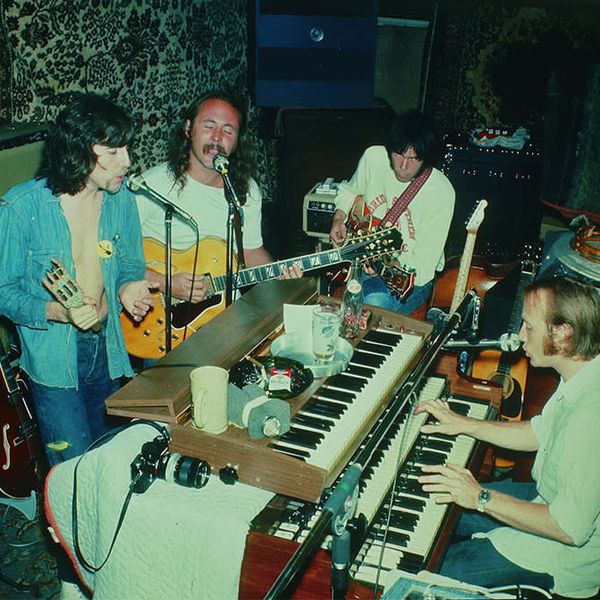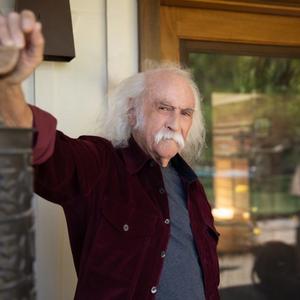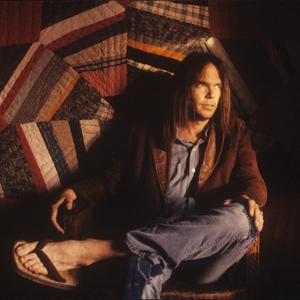




Link copied

In 1970, legendary San Francisco music promoter Bill Graham called Crosby, Stills, Nash & Young “the American Beatles”.
It’s a comparison that's stuck with the supergroup to this day - something they undoubtedly deserve, having cemented themselves as one of the most successful groups of the late 1960s and early 1970s.
With their political views nestled next to sincere love songs and hidden amongst ethereal harmonies, the group were arguably the only American band to have the same societal impact The Beatles had.
Here, Holler delves into the vital songs that made them one of the greatest groups of all time:
Marrakesh Express
The first offering from Crosby, Stills and Nash was ‘Marrakesh Express’, the lead single from their self-titled 1969 record. Originally written by Nash for The Hollies, it was rejected for not being commercial enough.
It bridged the gap between being in a quintessential British group to one that flew the flag for Los Angeles folk-rock like no other.
It tells the story of a train journey Nash took in 1966 from Casablanca to Marrakesh, capturing what he came across on the ride.
Stills was responsible for most of the musicianship on the track; the instrumentation embodying the breezy flow of the train journey carried through Nash’s lyrics and Jim Gordon’s drumming.
Suite: Judy Blue Eyes
In September 1969, CSN audaciously released the seven-minute ‘Suite: Judy Blue Eyes’ as a single from their debut record. Imitating the form of a classical music suite, an ordered set of musical pieces that were popular in dance music from the Baroque-era, the track has four distinct sections that are influenced by the ‘suite’ style of composition.
Written by Stills about his ex-girlfriend Judy Collins, it pays testament to the deep knowledge the group possessed for various sounds, while exemplifying the stellar harmonies and unconventional creativity they could deliver.
Guinnevere
As noted by the man himself, ‘Guinnevere’ is possibly the best song David Crosby ever wrote. Such serenity fills the song with an intimate tenderness, as Crosby compares Lady Guinnevere to the three women he loved; Christine Hinton, who was infamously killed in a car accident, Joni Mitchell and another who he has never revealed.
‘Guinnevere’ became such a marvellous composition, that even the great Miles Davis recorded a version of the song, something which took Crosby many years to fully understand.
Woodstock
‘Woodstock’ is paramount to the understanding and appreciation of such an infamous era. Originally written by Joni Mitchell, CSNY released their version on Deja Vu and has since gone on to be a staple of classic rock, surpassing Mitchell’s version in popularity.
The song comes full circle nevertheless; despite Mitchell writing it, she never attended the iconic festival – basing an account of the festival told to her by her then-boyfriend, Graham Nash.
Original demos of CSNY’s version even feature Jimi Hendrix playing bass and overdubbing guitar. The anthem is synonymous with the 1960s counterculture, while unquestionably becoming the best version of the song.
Teach Your Children
Much like ‘Marrakesh Express’, ‘Teach Your Children’ was written by Nash for The Hollies. Known for collecting photographs, Nash was inspired to write the sincere and tender song by a picture taken by Diane Arbus, which depicts a child playing with a toy hand grenade.
It’s a deeply moving composition; the country twang from Jerry Garcia’s pedal steel accompanies incredible harmonies that deal with themes of universal peace and love. After Garcia recorded his part for the song, CSNY would aid the Grateful Dead in improving their own vocal harmonies for years to come.
Our House
Joni Mitchell is a constant theme of CSNY’s music - the muse of various love songs out of Los Angeles’ Laurel Canyon. The most known though is this iconic number from Nash; written whilst he was living with Mitchell, he described the song as “an ode to countercultural domestic bliss.”
The song is simple but deeply effective; written in just an hour on Mitchell’s piano, he’s recalling a day where they went out for breakfast and bought a cheap flower vase. His ability to write a beautiful song from such an ordinary and relatable moment became a hallmark for the group.
Ohio
Here is one of the most important protest songs ever recorded. The band’s political standing was made crystal clear with Young’s brooding guitar tones and anti-Vietnam war sentiment.
Unlike the majority of CSNY’s music, ‘Ohio’ is dark and unwavering; recounting the events at Kent State where four innocent, unarmed students protesting the expansion of the Cambodian Campaign were murdered by the National Guardsmen.
Taking sharp jabs at Nixon’s Administration, the song was banned from AM radio stations, including in Ohio state. After its release, the band were made leaders and spokesmen for the American counterculture - truly coming to define CSNY.
Helpless
‘Helpless’ is a classic Neil Young song. Originally recorded for his band Crazy Horse, he saved it for CSNY - simply feeling that it would suit them better. After multiple demos, with the band struggling to decide on an arrangement, they settled on the slow and simple version heard on Deja Vu.
The song focuses on Young specifically, referring to his upbringing in Ontario, Canada. It’s one of Deja Vu’s showpieces, his incredible vocal performance cementing how important he had become to the group.
Subscribe and listen to Crosby, Stills, Nash & Young's best songs playlist below:

For more on Crosby, Stills, Nash & Young, see below:





